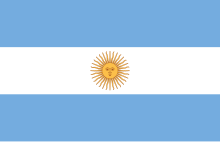You can help expand this article with text translated from the corresponding article in Spanish. (March 2009) Click [show] for important translation instructions.
|
This article includes a list of general references, but it lacks sufficient corresponding inline citations. (December 2019) |
| Argentina at the 1960 Summer Olympics | |
|---|---|
 | |
| IOC code | ARG |
| NOC | Argentine Olympic Committee |
| Website | www |
| in Rome | |
| Competitors | 92 in 14 sports |
| Flag bearer | Cristina Hardekopf |
| Medals Ranked 30th |
|
| Summer Olympics appearances (overview) | |
Argentina at the 1960 Summer Olympics in Rome, Italy was the eleventh appearance out of fourteen editions of the 1960 Summer Olympics. Argentina sent to the 1960 Summer Olympics its eighth national team, under the auspices of the Argentine Olympic Committee (Comité Olímpico Argentino), 91 athletes (all men), something which had not happened since the 1932 Games in Los Angeles and which has not happened since. Ironically, the flag bearer, a woman named Cristina Hardekopf,[1] was a diver but was not included in the delegation as a participating athlete. However, Jorge Somlay, a rower, participated as Argentina's youngest Olympic competitor at only 13 years old.
The Olympic team won two medals, one bronze and one silver, and five Olympic diplomas. They placed 27th in total medal count over 83 participating countries.
The silver medal was one in yachting[2] and the bronze in boxing,[3] giving Argentina half of its medals and 3 out of five of its Olympic Diplomas (something which was usual until the 1968 Summer Olympics in Mexico City).
Argentina's performance in the games forms part of a period of scarce results, which was affected by scarce support for the Olympic Games by the state as well as other political reasons. Repeating what happened in the 1956 Games in Melbourne, Argentina did not win a single gold medal, and the two medals that they did win were far below their average winnings of 4-7 medals in all of the games from 1924 to 1952. In 2004 Argentina's Olympic success recovered to the levels it had during the 1924-1952 period.
- ^ "Christina Hardekopf Biography". Archived from the original on 18 April 2020.
- ^ 1960 United States Olympic Book. New Haven, Connecticut: The United States Olympic Association. 1961. p. 193.
- ^ 1960 United States Olympic Book. New Haven, Connecticut: The United States Olympic Association. 1961. p. 99.